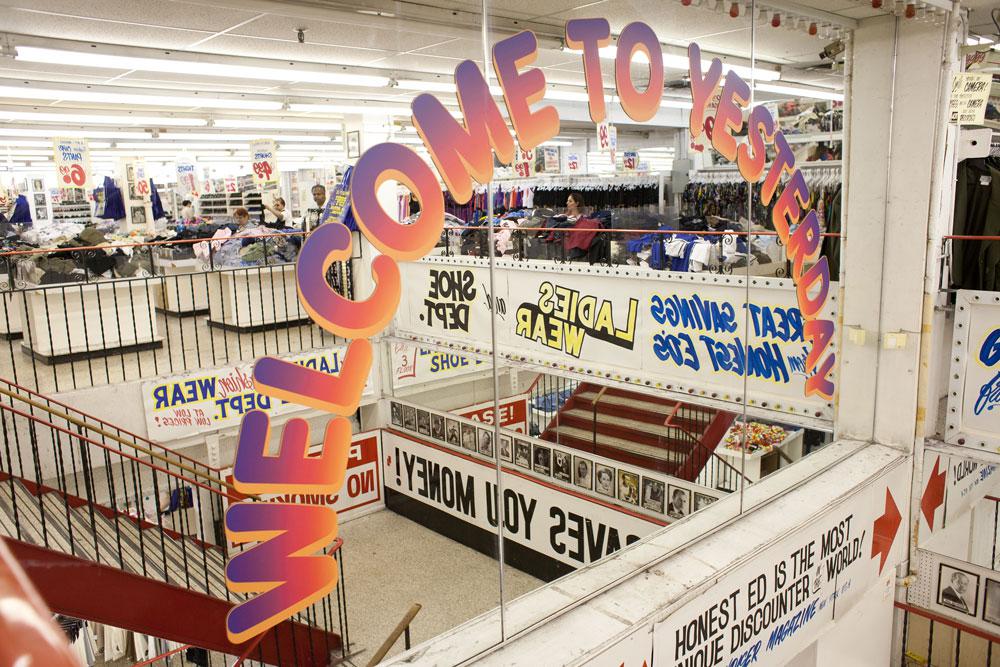Honest Ed’s is a time warp. The bright fluorescent lights, hand-painted signs and cluttered decor create an atmosphere set in the past. The latest Koffler Gallery Off-Site project “Summer Special” transforms the Toronto store/institution into an art-lover’s scavenger hunt; while some search for bargains, curious viewers track down subtle artistic inventions in and around the store.
At the back of the men’s department, a red alcove beckons. It is a related archival exhibition, “Historic Summer Special,” and the room’s deep-red walls are covered with an assortment of signs, hand-painted red and blue, that advertise low prices or make joking reference to the late Ed Mirvish, the man who founded Honest Ed’s. On a small TV, a series of interviews plays on loop, the topic being Honest Ed’s commitment to the dying art of sign painting. With this display serving as a helpful starting point—I’m new to Toronto and unaware of the lore around Mirvish—I head out with an exhibition pamphlet to locate the more contemporary installations.
Jen Hutton‘s Welcome to Yesterday adorns a staircase mirror in the women’s department. The purple and orange letters stand out from Honest Ed’s signature style, yet the message fits right in. Stepping into Honest Ed’s evokes a sense of nostalgia; there is a quality it elicits which no longer exists in most department stores. Although Hutton appropriates the phrase from the now-closed Memory Lane Books, which was once nearby, it poetically captures the store’s atmosphere.
Sarah Lazarovic‘s installation #TOmotto plays with the red and blue signs that dangle above the kitchenware department. Unusual phrases cheekily reference Toronto’s well-known street names and neighbourhoods. At first, the candid signs seem to be another aspect of the store’s eccentric decor. However, Lazarovic helped generate these snappy phrases on Twitter, and she cleverly incorporates them into the store’s signage.
Hunting for Corinne Carlson‘s Postcards quickly digresses into a tour of the store’s west wing. The small brown cards are tucked away in a back corner of the electronics department. The captions on each two-sided card present phrases such as “Happy Happy Happy” and, on the reverse, “Sad Sad Sad.” The phrases are unorthodox for the medium, but they seem to capture Carlson’s own candid thoughts.
Outside the store, there are more works.
Visible from the parking lot, Barr Gilmore’s The Son is a circular sign done in the same style as the large flashing ones that adorn the store’s exterior. Gilmore generates the text through scrambling the word “honest.” However, the sign is ambiguous, leaving it open to multiple interpretations. It is a sun, a beacon guiding all who see it to the landmark. (I later learn it is also a reference to Ed’s son, the art collector and former gallerist David Mirvish, who now carries on Ed’s legacy.)
Vancouver-based artist Ron Terada also takes on the store’s iconic signage. Four banners in its alley incorporate clever, unconventional marketing phrases. Unlike the other works that largely embrace the Honest Ed’s style, Terada places the phrases on abstract black-and-white canvases creating a clear reference to Frank Stella’s Black Paintings, drawing connections to the Mirvishes’ long support of the arts—Stella’s work included.
Circling back past the storefront—which also includes a window installation and movie by Robin Collyer—and re-entering Honest Ed’s, the cacophony of signs, which initially bombard the viewer, each become distinct. Signs that seem to deviate from the house style raise questions about what artists may have contributed to the landmark in the past.
Yet for Saturday-afternoon shoppers, the signs blend in with the decor that they have become accustomed to. For the interested viewer, “Summer Special” at Honest Ed’s transforms the discount-store experience into an artistic treasure hunt, revealing surprises at every turn.
This article was clarified on July 5, 2012, with the addition of information about Robin Collyer’s works in the exhibition.









